Last Updated on January 13, 2024 by Greg Gillson
Is the Nikon Monarch 7 ATB 8×42 any good for bird watching? I’m going to start with the conclusion.
Here is my opinion after owning and using this binocular for a full year and doing additional research:
The Nikon Monarch 7 ATB 8×42 binocular is the best bird watching binocular under $500. In fact, it may match or have advantages over binoculars costing twice as much.
For this reason, I believe these binoculars are also perhaps the best value for the money.
A recent binocular review by Cornell’s All About Birds (source) listed the Nikon Monarch M7 8×42 as one of their top 3 binoculars.
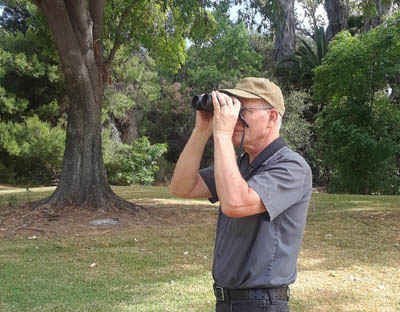 |
| Here I am using my Nikon Monarch 7 8×42 binoculars. May 25, 2020. |
Binocular specs (the numbers that matter)
| Model Size |
Price MSRP |
FOV @ 1000 yds |
Close Focus |
Exit Pupil |
Eye Relief |
Weight |
|---|---|---|---|---|---|---|
| Nikon Monarch 7 8×42 |
$479.95 | 420 ft | 8.2 ft | 5.25 mm | 17.1 mm | 22.9 oz |
The table above shows the important specifications that need to be considered before you even look at a bird through a potential pair of binoculars. Binoculars with specs outside of certain ranges will not be good for bird watching, even if they are otherwise excellent binoculars.
I realize that these terms and specs can be confusing. But they are important to understand when deciding which binocular to purchase.
The magnification of 8x and the objective lens size of 42 mm is ideal. Dividing the magnification into the lens size gives the value of 5.25 mm exit pupil. This is great for a bright view in low light conditions. It is also more than enough in bright conditions. Increasing the magnification to 10x would reduce the exit pupil and makes them less bright at dawn and dusk or cloudy days. So this 8×42 size is best for bird watching in dim or shadowed conditions.
The 420 feet field of view (FOV) at 1000 yards is amazing! Not many binoculars do better. I have an older pair of binoculars that only have 330 feet FOV. In comparison, they are like looking through a straw! I was looking at a nearby brick wall yesterday to compare the two. With the older pair of binoculars I could only see 5-1/2 cap bricks across the top width of the wall. With the Monarch 7’s I could see almost 8 bricks wide!
Okay, so what does this mean for birding? It means you will be able to follow the warbler hopping from branch to branch in the tree top. With less field of view the bird may hop out of view. You’ll have to put your binoculars down to re-spot the bird with your eyes. Wide field of view is very important for woodland birding. It is also beneficial for scanning in open country or viewing out to sea from shore. More magnification reduces field of view, this is why 8x is better than 10x.
The close focus of 8.2 feet is good, but not great. You should be able to focus on birds close to you in the bushes without having to back up. However, if you do butterfly watching you may want a binocular with closer focus–perhaps down to 5 feet.
The eye relief of 17.1 mm is just adequate for eyeglass wearers. To see all of that huge field of view I actually push my binoculars against my eyeglasses a bit sliding them closer to my eyes. Otherwise, if the eye relief is 15.5-16.5 mm the view may vignette–you won’t see the entire field edge-to-edge.
Eye relief on some binoculars goes all the way up to 20 mm–more than enough for all eyeglass wearers. Binoculars with eye relief of less than 15.5, perhaps all the way down to 14 mm or even 12 mm are unusable if you wear eyeglasses.
These are very light-weight binoculars for their size, at 22.9 ounces. That is due to their construction. They will put less strain on your neck and arms using them all day in the field.
The optical and physical binocular properties
No other group demands more of its binoculars than do birders. What do bird watchers want in a binocular?
- Sharp, bright image with accurate color
- Wide angle field of view
- Good magnification
- Ruggedly built, waterproof and fog proof
Does this binocular deliver? Oh, yes.
Sharp, bright image with accurate color
This binocular is built with all the best optical glass and prisms and all the best coatings that one would expect at this price range.
The lenses are made of Extra-Low Dispersion (ED) glass.
All lens surfaces are fully multi-coated.
The prisms have dielectric coatings.
The prisms are also phase coated. These give accurate color reproduction.
Together these provide a bright and contrastingly sharp view.
All these terms may sound like meaningless buzz words. But these exact terms are what you want to have for the best optical qualities. These Nikon Monarch binoculars have all the right terms and are missing none. Nikon manufacturing page is here.
I’ve tried to see the imperfections in the Nikon Monarch 7 that makes these a $500 binocular and not a $2000 binocular. Toward the edge of the image I do note that the image focus may be a bit softer. I do not notice the supposed darkening toward the edge. Nor do I notice the straight lines curve slightly at the edge of the field of view. I’m looking for it and can’t see it, though it is supposed to be there.
Actually, I do note some chromatic aberration at the edge of the field. Realize that you center your binoculars on the bird under observation and don’t intentionally place the bird on the very edge of view.
But when I look at dark branches against a bright overcast sky, right at the outer edge of the binocular field of view, I see it. The side of the branch toward the center of the field of view has a faint greenish edge. The side of the branch to the outside of the field of view has a thin purple fringe. It’s hard to notice, even when you’re looking for it (I’ve looked before and not seen it). This is normal for binoculars in this price range.
Wide angle field of view
We already discussed the very wide field of view of 420 feet at 1000 yards. This gives you a very spacious view.
You’ll be able to see what’s happening next to the bird you’re looking at. When scanning a distant shoreline you’re not going to miss a duck swimming off to the side or hawk perched up in a shoreline tree.
The field of view really takes a hit when increasing magnification from 8x to 10x. That’s for all binoculars.
For instance the Nikon Monarch 7 10×42 has a field of view of only 351 feet. That’s rather narrow and far below average for 8x binoculars, but slightly better than average for a 10x binocular.
Wide field of view is another reason I prefer 8x binoculars over 10x.
Good magnification
The 8 power magnification is the best for general purpose bird watching. I started out with 7x. And I’ve owned 10x binoculars. It is nicer to have more magnification without sacrificing field of view or introducing shakiness from hand movement. Thus, 8x is best.
If you do mostly mid-day open range birding (hawk watching or ducks or sea watching) then 10x is perhaps better.
Ruggedly built, waterproof and fog proof
These Monarch binoculars are light-weight but strong. That is because they are made with polycarbonate resin reinforced with fiberglass.
But that is under a rubber armor coating. This rubber is slightly tacky, that is, gripping your hands but without being sticky. It almost feels like soft leather covering the harder under binocular body. It’s very nice. They will not easily slip out of your hand as some other harder plastics.
The binocular is sealed with O-rings to keep water out to a depth of about 3 feet. That means you don’t need fear getting caught in a rain storm. You may even clean off ocean salt spray from your binoculars under a gentle trickle of water from your sink (not a powerful spray, though, just in case).
Inside they are filled with dry nitrogen gas. The lenses will not fog up on the inside on a cold day.
I bought a wide comfortable neckband a few years back and transferred it to my Nikon Monarch 7’s as soon as I bought them.
The accessories aren’t useful. Before I had in mind to review these binoculars I threw away the lens covers!
I’m not going to fiddle with ill-fitting lens covers in the field. They just get in the way of seeing birds. The soft carrying case I kept, but not for carrying the binoculars. I kept it for carrying lens cleaners and spare batteries and memory cards for my camera!
Similar Species (binocular comparisons)
There are some other binoculars similar in performance and price to the Nikon Monarch 7 8×42.
Namely, these are the Vortex Viper HD, Zeiss Terra ED, the Hawke Frontier ED X, and the Bushnell Forge, all 8×42 binoculars.
I don’t think you’ll have buyers remorse if you purchase any of these, except maybe the Bushnell Forge, which I’ll explain below.
You could probably find someone to argue that one of these other binoculars is their favorite. They are all very close. Even comparing side-by-side you may not readily notice the difference.
Nikon Monarch 7 vs Vortex Viper HD
This is a close call. The Vortex Viper might be slightly brighter. The manufacturers suggested retail price for the Viper is $150 more than the Monarch 7. That said, sometimes you can find the Vortex online for less than the Monarch 7.
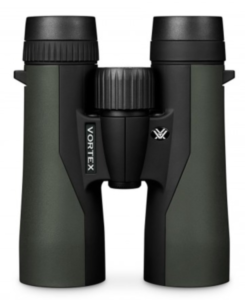
The Vortex comes with a chest harness for easy carrying and protection.
It also has a transferrable no-fault warranty. You break them, Vortex replaces them for shipping cost only. That might be part of the reason these are more expensive.
A Bird Guides reviewer (source) found that their Vortex Viper test binocular did not close focus to 6.5 feet as it was supposed to, but was more than 10 feet. That is probably an aberration. They have an excellent warranty; they should have been returned to the manufacturer for repair.
They did note that the image on the Vortex Viper was not as sharp edge-to-edge as the Nikon Monarch 7. Other reviewers said they were very sharp.
A review on Optics Observer (source) said that they preferred the Nikons (barely) over the Vortex. They listed 3 reasons: The Nikons have a slightly wider field of view, appeared to have a bit more depth of field (more forgiving focus), and were generally less costly.
Nikon Monarch 7 vs Bushnell Forge
A review by All Binos (source) showed that these Bushnell Forge binoculars have a low 85% light transmission. They will be dimmer in low-light conditions than the other binoculars here.
These binoculars also give an image that is slightly more yellow-green than true color hue.
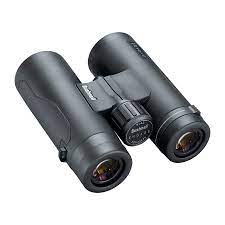
The specs show a close focus of 10 feet, which is a bit long for woodland birding. [But see the reader comments below for a different perspective that shows the manufacturer’s page may be in error!]
They are also heavier, at 30.8 ounces.
On the good side, they have excellent wide field of view, have good eye relief for eyeglass wearers, and have very low chromatic aberrations from center to edge.
Nikon Monarch 7 vs Zeiss Terra ED
The Zeiss Terra ED was designed to compete directly with the Nikon Monarch 7.
The Nikons are a mere 10 feet better in field of view, and are 2.7 ounces lighter.
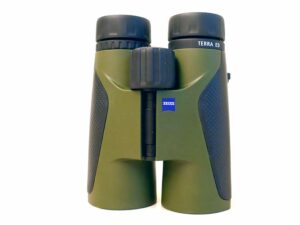
In the Zeiss’s favor, they focus almost 3 feet closer, down to 5.25 feet. They also have an additional 0.9 mm of eye relief, so they are a bit easier to use with eyeglasses.
A review by All Binos (source) says that the Zeiss binoculars have a “moderate” amount of chromatic aberrations in the center of view. That’s not good.
The Zeiss barrels are straight with no thumb indents that most binoculars have. They may be more uncomfortable to hold.
Nikon Monarch 7 vs Hawke Frontier ED X
These Hawke Frontier binoculars were reviewed directly with the Vortex Viper by Better Binocular Reviews (source) and compared nearly identically. Thus, they must be very similar to the Nikons in performance.
Bird Guides (source) reviewed the Hawkes and found a slight curvature in the field of view to mention.
Wrapping Up
The Nikon Monarch 7 8×42 binoculars are an excellent birding tool. I feel confident recommending them as the best binoculars for bird watching under $500.
Strengths
- Very wide field of view of 420 feet
- Excellent bright and sharp optical image
- Light weight
Weaknesses
- Narrow neck strap
- Nothing special about the accessories (carrying case and lens covers)
The other contenders for best bird watching binoculars in this price range are all excellent binoculars with wide field of view and good for eyeglass wearers.
The Bushnell Forge are heavier, slightly dimmer, and don’t focus as closely. [But read Matt’s comments below from October 20, 2020 that might contradict the brightness and close focus arguments.]
The Zeiss Terra are better for butterfly watching, because they do focus more closely, but the alleged chromatic aberration in the center is unfortunate.
The Vortex Viper and Hawke Frontier ED X may or may not be better than the Nikon Monarch 7, depending upon who you ask. The three of them are all very close. The Vortex has the best warranty, but is also the most expensive.
Frequently Asked Questions
Are Nikon binoculars the best?
Nikon binoculars boast a reputation for quality and performance, with a range of options catering to various needs and budgets. Here are some interesting facts about Nikon binoculars:
Optics and Technology:
- High-Quality Lenses: Nikon uses premium optical glass with advanced multi-coatings for superior light transmission, clarity, and color fidelity. Their ED (Extra-low Dispersion) glass in higher-end models further reduces chromatic aberration, resulting in sharper images.
- Prisms: Both Porro and roof prism designs are utilized in their lineup, offering various advantages in terms of weight, size, and light path efficiency.
- Field Flattener Lens System: Certain models incorporate this technology to minimize image curvature at the edges of the field of view, ensuring consistent sharpness across the entire frame.
- Stabilization (select models): Some high-end binoculars feature image stabilization technology to counter hand tremors and vibrations, providing a steadier view, especially at high magnifications.
Durability and Comfort:
- Weatherproof and Fogproof Construction: Most Nikon binoculars are sealed and purged with nitrogen gas to resist moisture and prevent internal fogging, allowing use in various weather conditions.
- Rubberized Armor: Many models feature grippy rubberized exteriors for secure handling and protection against bumps and scratches.
- Long Eye Relief: Some Nikon binoculars offer generous eye relief, accommodating those who wear glasses without compromising viewing comfort.
- Adjustable Twist-Up Eyecups: Many models have twist-up eyecups for optimal positioning and blocking stray light.
What does 8×42 mean on a pair of binoculars?
In the world of binoculars, the numbers “8×42” have a specific meaning related to two key features:
- Magnification: The first number, “8,” refers to the magnification power of the binoculars. In this case, it means objects will appear eight times closer than they would to your naked eye. This can be helpful for observing distant details, like bird feathers or wildlife markings.
- Objective Lens Diameter: The second number, “42,” refers to the diameter of the objective lenses in millimeters. These are the large lenses at the front of each binocular barrel that gather light from the object you’re viewing. Larger lenses collect more light, resulting in brighter and clearer images, especially in low-light conditions.
So, a pair of 8×42 binoculars magnify objects eight times closer and have objective lenses with a diameter of 42 millimeters. This is a popular choice for general-purpose binoculars that offer a good balance between magnification, brightness, and portability.
Related articles:
How to adjust your binoculars and how to use them to better spot birds: How to use binoculars for bird watching
If this price range is a bit high for you, please check out my in-depth review of the Celestron Nature DX ED 8×42. It is a budget binocular with excellent optics for under $200.



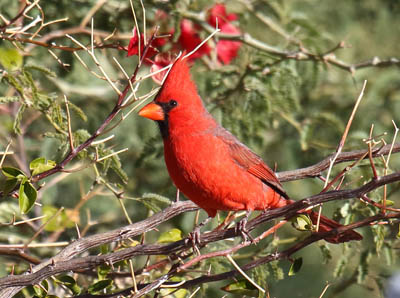
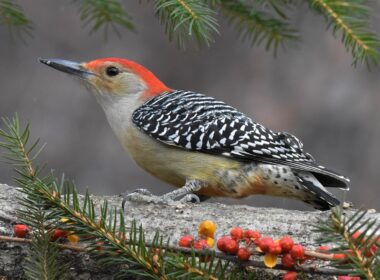
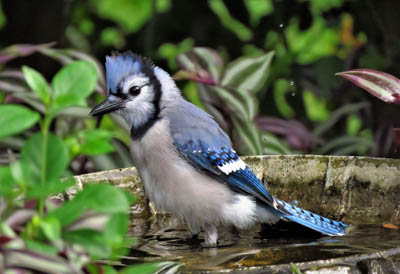
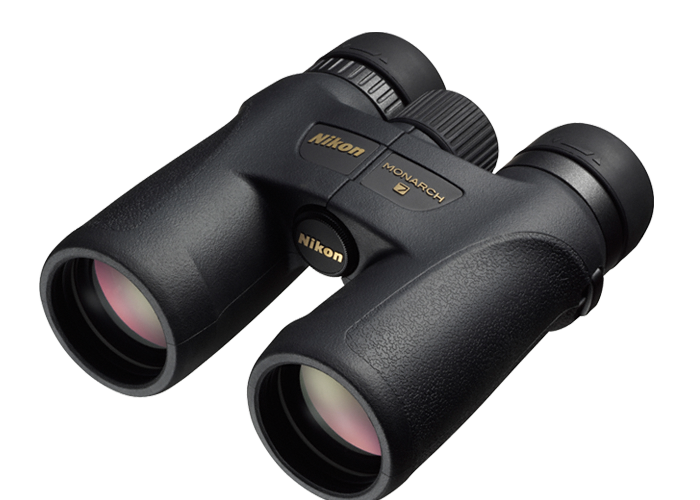

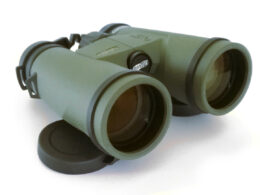
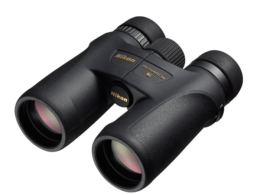
Hi, I'm a bit confused regarding the Bushnell Forge close focus distance. On Allbinos it says 1.6m, about 5.25 feet and they mention it again into the Pros section of the review "…sharp images already from 1.60 metres". On the Bushnell site, it says 10 feet. I'm wondering if anyone can tell which distance is the good one. Nice review, thank you for all the inputs. Not sure which one I'll buy yet, between Forge and Monarch 7.
Everywhere else it says close focus of Bushnell Forge 8×42 is 3 meters (10 feet). That's okay for open range and beach, but not woods or perhaps warblers in nearby bushes.
It is perhaps 25-30% heavier than other binoculars available in this price range. They seem to be ruggedly constructed for hunting applications. Something to keep in mind for all-day bird watching and hanging around your neck.
Hi again Greg! I just bought a pair of Bushnell Forge 8×42 after comparing them side by side at the store with the Nikon Monarch 7 8×42, and the Vortex Viper 8×42. I can confirm to you that the minimum focus distance of the Forge is less than 6 foot, and that the Nikon focuses at about 8 foot. Event The Forge 10×42 is about on par with the Nikon focusing distance at around 8 foot, maybe less. Definitely, the Nikon is much more compact, and a bit lighter. I do not understand Bushnell specs on their site and their 10 foot focusing distance. I preferred the image quality of the Bushnell. It was brighter ( I know right? I have also read Allbinos review and their light transmission result…)and less distorted on the edge. For the shape of my eyes, if I can call it likeso!, I preferred the Bushnell. There was less light coming from the side of the eyepieces. I do not wear glasses. Nikon image quality was great too, but at the end, I chose the Bushnell from what I have experienced. The Viper did not have better arguments over Nikon or Bushnell, and were more expensive. This is my 2 cents and I'm pretty much sure any of these binoculars would make a good choice! Thanks again for your review, it helped me out! Cheers! Math
Thank you so much for checking back, Math!
Your direct-comparison is so valuable!
You are right. There probably isn't a bad choice here.
The Bushnell Forge are definitely heavier.
Other specs are similar.
I appreciate you reporting what you found.
Thank you!
I have Trailseeker 10X42 ED binoculars. I'll appreciate your opinion Greg, if its worth to upgrade to Hawke Frontier 10X42 ED X (HD X) model?
Both (ED models) are good binoculars for bird watching.
Frankly, I'm not sure you'll notice the difference between these models.
They all have the same specs as far as close focus (8.2 feet) and field of view (336-340 feet @ 1000 yards). Magnification and weight is the same. Both are built with strong magnesium body.
The ED model of Frontier is better glass than the HD model.
The Frontier ED X is the same glass (extra low-dispersion) as the Trailseeker ED.
So, the Celestron Trailseeker 10×42 ED = Hawke Frontier 10×42 ED.
However, the Hawke ED is $200 more than the Celestron ED. That could imply that it is better quality.
The Hawke comes with a lifetime free no-fault damage or defect repair warranty.
Celestron has a 2 year manufacturers defect warranty.
That also seems to imply the Hawke is built sturdier.
Unless you are doing open country (hawks, ducks) I always recommend 8x, as it is brighter in dim conditions, has much more panoramic field of view, and is more comfortable for eyeglass wearers.
Please see my article on binoculars for less than $500:
https://whatbirdsareinmybackyard.com/2020/01/best-birding-binoculars-under-500-dollars.html
Is it worth it? If you are happy with the Celestron then you probably won't know the difference. Is the warranty worth 2/3 more price to you?
When I was purchasing Trailseekers, I compared them in store with a few other models. Among them – Celestron Nature and Vortex Diamondback. Of course, it was a limited testing in store, but a felt that Trailseekers advantage in image quality. Could not describe why, just felt it. Probably a bit brighter and more "3D" feeling. I also tried Vortex Razor and I was impressed, that it had a noticeable image brightness advantage over Trailseekers. But with the price of it 3x more, it should be.
They didn't have Frontier and Viper, that priced somewhere in between Trailseeker and Razor, so I have no idea if any of these two would be noticeably better than Trailseeker.
Greg, I'm the guy who had a conversation with you under another article about magnification and my preference for 12X bino. I'm a shore birds observer. Tried many times to compare 12x and 10X, and could not find any advantage in image using 10x over 12x. AAMOF when using 10x I feel that I'm missing something. But maybe if there are better quality 10x it will work better for me? And that's why I needed advice about Frontier, Viper or maybe other models with price tag of couple hundred dollars more than Trailseeker. Will it work?
P.S.1 Judging binoculars performance based on its specs and its price is a bit short from the real field experience.
P.S.2 You didn't feel the difference in your testing between Nature and Monarch7? Really?
If you are that much into viewing shorebirds I understand your need for more magnification.
Rather than trying to get binoculars to magnify more, you should really be looking at spotting scopes.
Because there is only one lens, you can get decent spotting scope in the price range of the binoculars you are wondering about. Not the best, mind you, but better than binoculars of 10x or 12x or even 15x.
Many important characters of binoculars are inferred from their specs. That helps eliminate some right away. Image quality, though, does need side-by-side comparison.
And, yup, I was impressed by the Nature DX ED in side-by-side comparison with the Monarch 7. In fact, I've been thinking lately of using them more often.
I haven't priced and compared scopes for over a decade, though, so you need someone else's opinion. A zoom range of 20-60x is typical.
Here's a page from Audubon that can start you with choosing spotting scopes, if you so desire.
If you're going to spend close to $500, a spotting scope is a far better value for finding shorebirds than another binocular very similar to what you already have!
https://www.audubon.org/gear/scope-guide
I think we have a misunderstanding. I'm not a high-power-bino freak. I do have a spotting scope. And you probably going to be surprised, but my choice of it for my needs was actually a compact size (12-36×50 or 15-45×60). Why not bigger and more powerful? First think I'm looking is a "balance". I don't need more power for my needs and compact size was more important to me. But my use of it (plus tripod) is limited, because I like to go birding light. More often just with one bino.
I understand that our interests in birding are different. Yours for backyard birds, mine for shore birds. Yours – for smaller birds on trees, mine for larger ones in open area. Yours for shorter distances, mine for longer. Even so, my distances for observing them are limited. I kind of work out a rule for the best observation and its came out to be the size of football field. Its good within length of it and better within width of it. Or another way – the distances where I can recognize birds with my naked eyes would be enjoyable to see them up close with binoculars or even spotting scopes (maybe a bit longer).
So, the reason for me to use 12x binoculars is not to see birds for further away, but within distance I would use 10x too.
Great bblog post